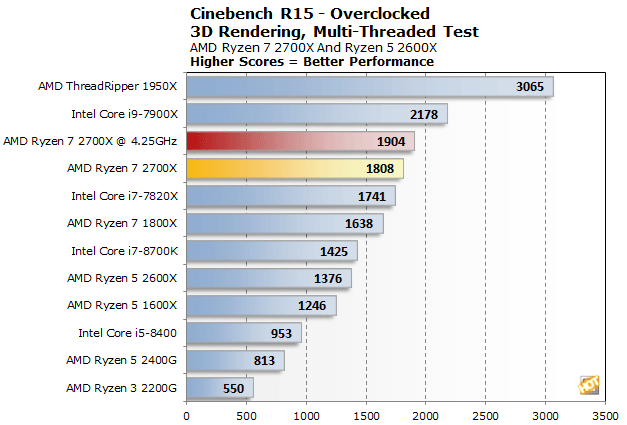AMD 2nd Gen Ryzen Review: 2700X And 2600X Deliver More Performance Per Dollar
We also spent some time overclocking the AMD Ryzen 7 2700X, to see what kind of additional horsepower the processor had lurking under its hood. AMD may have cranked up the clocks and TDP with this processor already, but there's usually some additional performance to be gained with a little tweaking.
|
Overclocking a 2nd Generation Ryzen processor is very similar to first-gen parts. Because the processors are unlocked, overclocking it is simply a matter of altering a few multipliers, tweaking voltages, and dealing with the additional heat and power requirements. These processors can also be overclocked by adjusting base clock frequencies though, so it's possible to really fine tune the end result.
As was the case with the originals, overclocking can be done from within the BIOS on enthusiast motherboards or via AMD's Ryzen Master software. Ryzen Master gets a major update with this launch, however.
The latest version of Ryzen Master includes a number of interesting and worthwhile updates and features. We'll quote AMD directly to keep it simple:
- Package Power Tracking (“PPT”): The PPT% indicates the distance to maximum power that can be delivered to the socket by the motherboard across various voltage rails. 100% indicates maximum capacity.
- Thermal Design Current (“TDC”): The TDC% indicates the distance to maximum current that can be delivered by the motherboard voltage regulators when they have been heated to a steady state through sustained operation. 100% indicates maximum capacity.
- Electrical Design Current (“EDC”): The EDC% indicates distance to maximum current that can be delivered by the motherboard voltage regulators in a peak/transient condition. 100% indicates maximum capacity.
- Fastest Core Detection: The stars represent the fastest core(s) within each CCX, while the gold star indicates the fastest silicon in the entire device. The circles represent the second fastest cores within the CCXes. This can be extremely useful for breaking single-core clock speed records.
- Per CCX Overclocking
We took a somewhat conservative approach to overclocking the Ryzen 7 2700X to give you all an approximate “worst case scenario”. Our results should be repeatable, assuming you’ve got similar hardware and everything is working properly. You shouldn’t need exotic cooling to pull off what we did here -- we used the included Wraith Prism cooler with the motherboard and processor installed in a mainstream NZXT mid-tower. Of course, more exotic coolng will result in higher overclocks, but its not a necessity.
To see what our chip could do, we manually cranked the core voltage up to 1.4v and shot for a modest 4.2GHz (42x100MHz), which worked without incident. We then moved up to 4.3GHz, but had some instability under load, so we backed things down a bit and settled at 4.25GHz across all cores. At this speed, the chip was perfectly happy with the Wraith Prism Cooler and operated in the upper 80-degree range when under load. Idle temperatures were relatively cool and stayed in the low 30's.


While we had the chip overclocked, we re-ran a couple of benchmarks and saw some nice performance improvements. They weren't enough to push the Ryzen 7 2700X up a notch in the charts, but they did allow AMD's 8-core chip to come within striking distance of the 10-core Intel Core i9-7900X.

We should also mention that memory overclocking is much better with 2nd Gen Ryzen processors and an X470-chipset based motherboard. With minimal tweaking, we hit DDR4-3533 speeds. To give you an idea as to what memory at these clocks can do, our setup just missed the 41GB/s mark -- up from the stock 33GB/s when running at the maximum officially supported speed of 2933MHz.
|
Throughout all of our benchmarking and testing, we also monitored how much power our 2nd Gen Ryzen test system was consuming with a power meter, versus the other systems we used for benchmark comparisons.
Our goal was to give you an idea as to how much power each configuration used while idling at the Windows desktop and while under a heavy CPU workload. Keep in mind, this is total system power consumption being measured at the outlet and not the the individual power of the CPUs alone.

Idle power is somewhat improved with the 2nd Generation Ryzen processor, but peak power is actually somewhat higher. The move to Global Foundaries' 12nm LP process allowed AMD to reduce the voltage at a given frequncy, which will reduce power consumption clock-for-clock, but because AMD also took the opportunity to increase frequencies and maintain higher boost clocks on more cores, peak power consumption is actually higher than the original Ryzen parts. Even still, the increased power consumption is commiserate with the performance improvements and is still in-line. The Ryzen 7 2700X outpaced the Core i7-7820X on a few occasions and it did so at lower power.

We also monitored power while overclocked and saw an approximate 30 watt increase under-load, due to the higher clocks and voltages used to hit 4.25GHz. The jump in power while overclocked is relatively small though, which shows that AMD is already pushing the limits somewhat and being a bit more aggressive with the Ryzen 7 2700X's stock power profile and frequencies.








